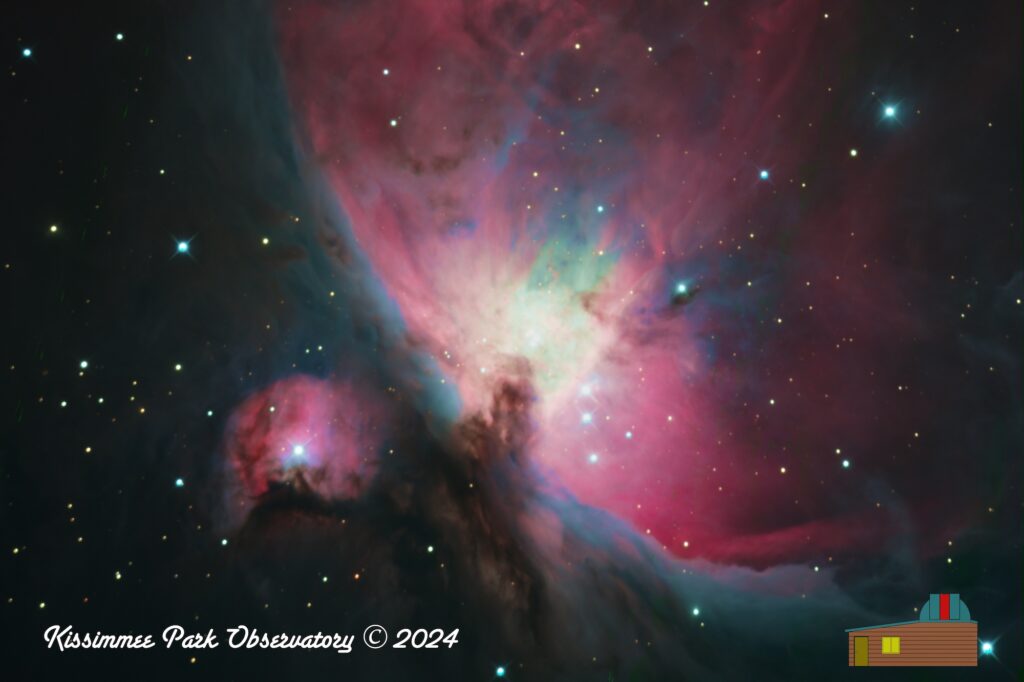
An HaLRGB image of The Great Nebula in Orion, as captured by the RC-12 Astrograph in the KPO dome. In order to capture details in the delicate core, only 10 second subframes were used. With the 360 subframes captured, the total integration time is only 1 hour to capture this; the brightest nebula in the northern skies. Click on the image to view a larger version you can explore.
The Majestic M42: Exploring the Great Nebula in Orion
Introduction
In the constellation of Orion, there lies a spectacle of cosmic proportions known as the Great Nebula, or M42. This celestial wonder is not only the largest emission nebula in the northern sky but is often heralded as the most famous nebula in the heavens. Let’s delve into why M42 captivates astronomers, astrophotographers, and sky enthusiasts alike, exploring its grandeur, its significance, and how one might best observe this stellar nursery.
Overview of the Great Nebula in Orion
- Location and Size: Nestled in the sword of Orion, M42 spans about 24 light-years across, making it a vast expanse of gas and dust when viewed from Earth, which appears as a fuzzy patch to the unaided eye.
- Discovery History: Although known since ancient times, it was formally cataloged by Johann Bayer in 1603 and later included in Charles Messier’s catalog in 1771, where it became M42.
Why M42 is So Famous
- Visibility: Its brightness makes it visible to the naked eye under moderately dark skies. However, to truly appreciate its detail, even modest binoculars will reveal the nebulosity surrounding the Trapezium, a tight group of young, hot stars at its heart.
- Astrophotography: M42 has become an iconic target for astrophotographers. Its complex structure, with dark dust lanes, glowing gas, and the bright stars of the Trapezium, offers a visual feast even with basic equipment.
- Cultural Impact: The Great Nebula’s inclusion in numerous myths and legends, its role in scientific discovery (like the first discovery of a “new star” within it by Johann Bayer), and its frequent depiction in art and literature cement its status.
Observing M42
- With the Naked Eye: On a clear night, you’ll see a fuzzy patch or a star-like object just below the belt of Orion. This is the combined light of the nebula and its central cluster.
- Binoculars or Small Telescope: Even a pair of binoculars can reveal the nebula’s glow and the central stars of the Trapezium. A small telescope starts to show the nebulosity more clearly.
- Larger Telescopes: With moderate to large telescopes, one can explore the intricate details of M42, including the dark lanes of B33 (the Horsehead Nebula, though not directly part of M42 but nearby), and the fainter parts of the nebula extending towards M43.
- Filters: An Orion Nebula filter can enhance the contrast of the nebula against the background sky, making the nebulous structure stand out more vividly.
Scientific Significance
- Star Formation: M42 is an active star-forming region. The Trapezium stars, with their intense radiation, are ionizing the surrounding gas, causing it to glow. This process provides a live demonstration of how stars form from collapsing clouds of gas and dust.
- Protoplanetary Disks: Observations with advanced telescopes have revealed protoplanetary disks around some of the young stars, suggesting that planetary systems might be forming right before our eyes.
- Variable Phenomena: The nebula’s environment changes over time, with stars being born, and their light and stellar winds sculpting the nebula. This dynamism makes M42 a subject of ongoing scientific interest.
Final Thoughts
The Great Nebula in Orion, M42, stands as a testament to the beauty and complexity of our universe. Its accessibility to amateur astronomers, its breathtaking visual appeal, and its role in advancing our understanding of stellar nurseries make it unparalleled in its fame. Whether you’re peering through a telescope for the first time, capturing its ethereal beauty through the lens of a camera, or studying its dynamics as a professional astronomer, M42 offers endless fascination. It’s a reminder of the cosmos’s vastness and the life cycle of stars, all encapsulated in what is arguably the most celebrated nebula of the night sky.
Image Info
-
- Imaged at KPO, Saint Cloud, FL
- Camera : ZWO ASI2600MM Pro
- Scope: Orion 12″ Ritchey Chretien Astrograph
- Mount: iOptron Smart-EQ Pro
- Hydrogen Alpha: 90 subframes of 10s = 15 min integration
- Luminance: 90 subframes of 10s = 15 min integration
- Red: 60 subframes of 10s = 10 min integration
- Green: 60 subframes of 10s = 10 min integration
- Blue: 60 subframes of 10s = 10 min integration
- Total integration time: 60 min = 1 hour.
- Captured via ASIAir Pro automation
- Optical tracking via ASIAir automation via the ASI174mm Pro guide camera
- Separate channels stacked and HaLRGB integrated in Astro Pixel Processor
- Image run through Super DeNoising
- Final processing in Aperture
